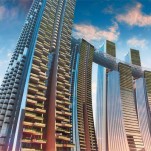Sailboat Sailing in the Future

Often the governing factor in the success of architectural design is its well thought referencing to the site locality. The building should be blended in with the surrounding landscape - this is not a secret. But some architects go further, not only taking into account the georeferencing of a given building, but also in an interesting way playing with the place history, and at the same time attempting to look into the future.
The history of China is back thousands of years. At the same time, the speed at which changes occur in this wonderful country, never ceases to amaze and delight the foreigners. There are built roads, modern industries and grow fantastic skyscrapers, and all of this is somehow inexplicably blended with the existed ancient sights and eternal traditions.
The city of Chongqing founded more than three thousand years ago is a vivid example of Chinese modern and ancient history. Tradition associates Chongqing with the State of Ba. Its modern name, which in Chinese means “double celebration”, the city received just 800 years ago. During the Second Sino-Japanese War (1937–1945) it was Generalissimo Chiang Kai-shek’s provisional capital. Due to the bravery, contributions and sacrifices made by the local people during World War II, Chongqing became known as the City of Heroes. Many factories and universities were relocated from eastern China to Chongqing during the war, transforming this city from inland port to a heavily industrialized city.
Today, Chongqing is the largest city of the world: its area of almost 82,5 thousand square kilometers is comparable to the size of any European country - for example, Austria. And also Chongqing is one of the major commercial centers in China with developed automotive, chemical and metallurgical industries, there also operates more than a thousand research institutions. Chongqing is one of the most important inland ports in China.
There are numerous luxury cruise ships that terminate at Chongqing, cruising downstream along the Yangtze River to Yichang, Wuhan, Nanjing or even Shanghai. In the recent past, this provided virtually the only transportation option along the river. Improved access by larger cargo vessels has been made due to the construction of the Three Gorges Dam. This allows bulk transport of goods along the Yangtze River. Several port handling facilities exists throughout the city, including many impromptu river bank sites.
Full content of this issue you can read here
The full version of the article can be read in our printed issue, also you can subscribe to the web-version of the magazine
 Materials provided by Safdie Architects
Materials provided by Safdie Architects


